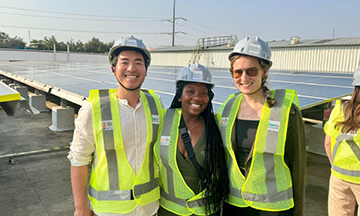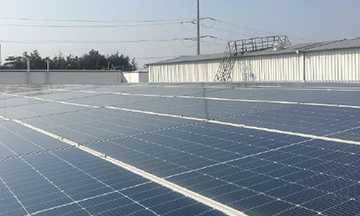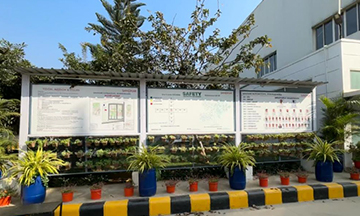Professor Vikram Gandhi’s Immersive Field Course (IFC) “Development while Decarbonizing: India’s Path to Net-Zero" delved into the critical aspect of decarbonization and sustainability goals amid India's rapid development. The course presented an opportunity for students to advance their knowledge of sustainability efforts, decarbonization, and net zero in the context of a broader development agenda. The class culminated in a series of site visits in January 2024 in Mumbai and Bangalore and this is one of 14 student essays that highlights their reflections on uncovering sustainable solutions across the country.
During the “IFC: Immersive Field Course,” HBS students had the opportunity to visit the site of a rooftop solar facility in Bangalore, India. The solar site is deployed and managed by CleanMax, the largest B2B provider of renewable energy to commercial and industrial customers in India. As part of the course, we were tasked with researching the state of renewable energy - specifically solar and wind - development in India. Companies like CleanMax play a critical role in pushing deployment of clean energy in the country.

Headquartered in Mumbai, CleanMax offers a range of services, including rooftop solar installations, project commissioning, and asset management to over 350 corporate companies across various industries. Founded in 2011 by Kuldeep Jain and Sushant Arora, the company has grown tremendously since then and taken on financing from global investors like Brookfield Asset Management and the International Finance Corporation (IFC). In 2017, the firm expanded operations beyond India into the UAE and Thailand.
CleanMax initially entered the renewable energy space by pioneering the “Energy Sale” model in India. This model, also known as the “OPEX” model, shifts the performance risk of renewables from the corporations to CleanMax, allowing customers to pay only for energy consumed without upfront asset investment, thus saving customers 20-40%. The founders, Kuldeep Jain and Anand Shah, realized corporations were seeking cost efficient ways to reduce their environmental footprint while simultaneously the cost of solar energy was decreasing.
There are several key accomplishments under CleanMax’s belt, including 1.6 GW installed solar and wind capacity globally and over 550 completed rooftop solar installations. CleanMax has played an integral role in India’s transition to renewables and received many awards. CleanMax was the first Indian company to win the prestigious Transformational Business Awards 2018 by Financial Times (FT) and International Finance Corporation (IFC) in Achievement in the “Transformational Infrastructure” category. They are committed to being the sustainability partner of choice for private users by helping customers meet 100% of their energy needs through renewable energy.

The site visit started off in a modern office setting with a presentation from CleanMax leadership on the energy sector in India and their particular business model. The team shared several key statistics on the state of renewable energy in India, pointing out that roughly 20% of India’s electricity consumption today comes from renewable energy sources while the country’s goal is to have 50% of electricity consumption powered by clean sources by 2030. CleanMax executives shared that solar is cheaper than grid electricity in all cases in India, regardless of geography and use-case. Despite this fact, India is continuing to deploy new fossil fuel power generation, largely because of (a) the tremendous energy demand forecasts of the country and (b) inadequacies in grid infrastructure and energy storage.
After the office presentation, we drove about an hour away to the solar site. The site was a factory of an automobile parts manufacturer. The manufacturing company is a customer of CleanMax and pays CleanMax a recurring fee for the solar energy generated on the roof of its factory. The solar system was separated into three sections on various rooftops of the factory and rated at a power capacity of 240 kW. At the site, we were met by the CleanMax asset manager tasked with managing the operations of this solar site. We followed him up three flights of stairs to the roof of the factory where the solar panels were situated (pictured below). The whole system felt modern, clean, and well-maintained. The CleanMax employees gave an overview of the site, explained the various parts of the site (the modules, the inverters), and answered a barrage of questions from inquisitive MBA students.
From an operations and maintenance perspective, we learned that CleanMax performs three solar module cleanings per month to ensure optimal performance of its solar site. On other sites they perform four to five cleanings a month, dependent on the level of soiling and dusting on the location. They separate their maintenance activities into reactive, preventative, and predictive maintenance.

Students learned that India’s power distribution companies (DISCOMs) cap the solar capacity of sites like the one we visited to 85% of the demand of the facility. This is to ensure that some percentage of electricity purchased by the facility comes from the DISCOM. This sparked conversation amongst students on the role of DISCOMs in the energy transition – are policies like these helping or hurting the clean energy transition? Another key topic of discussion during the site visit (and really a theme throughout the IFC course) was the supply chain dependence on China and associated geopolitical risk. India’s solar industry is currently heavily reliant on Chinese solar modules with domestically produced Indian modules over 40% more expensive than Chinese modules. With more protectionist policies potentially being imposed by the Indian government, will Indian solar companies be able to meet its deployment goals without the use of Chinese solar modules? Will Indian solar module manufacturers be able to bring its costs down quickly enough for India to transition its energy system to clean power?
As a team, two of us (Alliyah and Rory) are newer to the world of climate and one of us (Adam) has long been passionate about the climate issue and the energy transition. We all found the site visit to CleanMax to be a special experience. Adam had been to solar sites before but not one in a country like India. The challenges they face are unique, but given the successful track record to date and the level of expertise the team seems to have, we left the site inspired and optimistic about the impact companies like CleanMax will have in decarbonizing India’s future.

